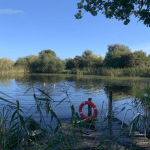Get naked
This weekend I visited an open water swimming venue I haven’t been to since last year. The first thing I noticed was the huge number of cars parked there. The second was the long row of (mostly very expensive) racing bicycles and the third, several groups of enthusiastic looking youngsters. The place was packed, and this was early on a blustery Sunday morning.
The majority of these people are triathletes but a significant minority were just there for the swimming. From what we’ve heard a similar story is repeating itself across the UK, and this is all great news for open water swimming and of course for us as a magazine dedicated to the sport.
But out of the more than 100 people there, barely a handful entered the water without encasing themselves in rubber.
Let’s be clear, we don’t have anything against wetsuits or wearing them for swimming. In fact we partly credit them with driving the current growth in open water swimming. They’ve allowed thousands of people to enjoy swimming outside and we recognise and enjoy their speed benefits when racing.
At the same time, we encourage people to shed their wetsuits, to get as naked as common decency allows, to really appreciate open water swimming.
Contesting the non-wetsuit cateogory of our National Series
Lakes in the UK South East are currently hovering around 15 to 17 degrees Celsius, similar to the temperature of the English Channel for the majority of solo crossings. Those swimmers stay in the water for up to 20 hours (the record is even longer), which suggests a short dip – say 15 to 20 minutes – in water of that temperature should be manageable for most swimmers. It does take a bit of getting used to, but here are some suggestions of why we think it’s worthwhile.
- There’s nothing quite like the feeling of swimming in cool water. Once you’re over the initial shock you enter a phase where the water feels cold on your skin but you are not cold. It’s an amazing all-over sensation that lasts until you start to feel chilled on the inside, which for most people would probably be a sensible time to get out.
- Despite appearances to the contrary, you feel great afterwards.
- Even if you do all of your racing in a wetsuit, spending some time in cold water without a wetsuit will help you acclimatise more quickly (you still need to acclimatise to cold water even if you wear a wetsuit).
- You get to enjoy a freedom of movement that’s impossible even in the most expensive and flexible of wetsuits.
- If you are a triathlete you may one day encounter water of 22.1 degrees, in which case wetsuits are banned (for standard distance events). If you’re used to swimming in water cooler than this, you will find 22 degrees quite comfortable while some of your competitors will be terrified.
- Bragging rights
- Once you get used to non-wetsuit swimming you can take part in some of the British Long Distance Swimming Association’s fantastic events (see our Aug/Sep 2013 issue for more on this).
We should end this call for non-wetsuit swimming with a caution. As well as keeping you warm, wetsuits also keep you afloat. You therefore need to take extra precautions when swimming without one. Swim with other people, consider towing an inflatable of some kind (to rest on if you get tired and to make you more visible in the water) or ask someone to accompany you in a kayak.
A while back we posted a piece on how to use a wetsuit to help you become a non-wetsuit swimmer. You can read that here.






